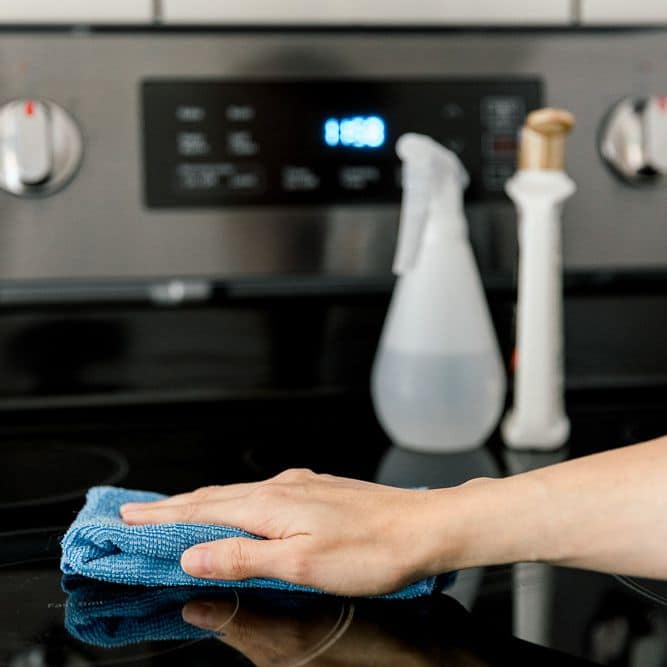Progress does not stand still, and one of its manifestations for housewives is the emergence of various household appliances that, compared to the previous mass, have useful properties. For example, massive hobs have been replaced by hobs, which are lightweight, comfortable and very ergonomic.
However, despite the advantages and attractive appearance, the question of cleaning and its proper appearance remains open. No matter how careful you are in preparing culinary masterpieces, drops of fat, smoke, cooked soups and other liquid dishes, as well as other stains, will remain on the surface of the plate.
Of course, they should be wiped quickly with a cloth after cooling, but there are times when this cannot be done, so on our kitchen helper we get ugly burns and stains.
Despite the traditional Russian tradition, before you start using the board, carefully read the rules of its operation and maintenance! This will save you unnecessary trouble, and it will allow you to serve you for many years with faith and truth.
The glossy surface should be cleaned daily after use.
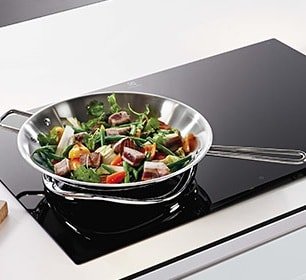
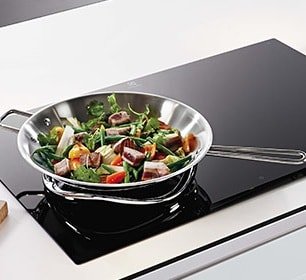 If you have cooked carefully, without burnt food residue, you can simply wipe the surface with a damp cloth and wipe dry without streaks.
If you have cooked carefully, without burnt food residue, you can simply wipe the surface with a damp cloth and wipe dry without streaks.
For cooking you only need to use clean dishes with a flat bottom. During use, cracks and dents will form on the pans, which can damage the hob and leave scratches during cooking.
Therefore, the purchase and installation of a glass-ceramic hob is an excellent reason to update the arsenal of kitchen utensils.
Moreover, the lids of pots and pans must be chosen strictly according to the diameter of the dishes. Otherwise, condensed water will drip onto the plate. Even if the usual scrambled eggs are cooked, you will have to wash the plate afterwards.
What absolutely should not be done when cleaning the hob?
Ignore the basic rules of household safety. In this case, this means that the plate should be washed only after it has cooled completely, which will not allow you to burn yourself.
In addition, it is worth washing the surface only with the use of gloves to protect the skin of the hands from detergent chemicals.
Do not clean the plate with metal wire sponges or coarse abrasive compounds. Moreover, you should not use knives, rough scrapers and other objects that scratch the surface.
This rule is important because various scratches and chips can worsen the condition of the surface, and this will negatively affect the appearance of the board.
What products and tools to use for cleaning?
- Soft sponges, rags … They must be specially selected for cleaning the hob. It must always be clean and dry. You can use microfiber cloths and melamine sponges. To quickly remove streaks after washing, you can use rubberized cloths.
- No matter how classy it sounds, it makes sense to buy special scrapers for similar surfaces … No other item, let alone a knife, spoon or stick, can replace this tool in terms of efficiency. Don’t imagine, just buy a plastic scraper from the store.
- Special liquids for removing stains and streaks from glass-ceramic surfaces. They do not contain aggressive abrasive particles, contain substances that break down grease, soften deposits and are easy to use. As a rule, such products must be applied to the surface for a few minutes and then rinsed with water.
How can I quickly and efficiently clean the hob?
To clean the board, you will need to observe a certain sequence of actions.
- To do this, you must first properly wipe the surface and remove droplets, light dirt and moisten all burnt dishes.
- After that, the surface should be treated with special agents and left to act for the time indicated in the note to the agent. Then rinse the product.
- Remaining dirt with which the product has not been resolved will need to be wiped off by hand. A scraper is the best tool for this, but you shouldn’t pick the surface hard. Holding it at a slight angle, it is best to wipe off the existing dirt with gentle sliding movements.
- After these manipulations, the surface should be wiped again with a cloth.
Folk remedies for removing stains from the surface of the glass-ceramic hob
To clean the surface, many experienced housewives use products that they prepare themselves.
 Such folk remedies generally include acids – citric or acetic acid, chemical dishwashing detergent, as well as a mild abrasive found in any home – soda.
Such folk remedies generally include acids – citric or acetic acid, chemical dishwashing detergent, as well as a mild abrasive found in any home – soda.
Vinegar and soda are used together and, while the violent reaction lasts, are applied to the problem area. It breaks down stubborn, dried stains and easily removes them.
But citric acid, soda and dishwashing detergent are mixed to the consistency of a thick paste and applied to the dirt.
Then, in the same way as removing specialized products, they are washed with a clean damp cloth.
Which means – folk or store-bought – that you’ll use to keep the hob clean.
One way or another, if you are careful and considerate of your glossy glass-ceramic hob, it will always delight you not only with its direct purpose – cooking – but also with its beautiful appearance. After all, if you take care of home appliances, then its lifespan will be longer.
A few practical tips below will help you quickly and efficiently clean any hob, and even … take preventative measures against stubborn dirt.
Take care of your glass ceramic and induction hob
If you have an induction or glass-ceramic hob in the kitchen, apply a liquid intended for cleaning kitchen surfaces to clean it of dirt and, soon after, wipe it well with an absorbent cloth. Be careful not to damage the glass surface, which means disposing of abrasive objects (for example, a metal cloth to remove dirt, which is always tempting to use).
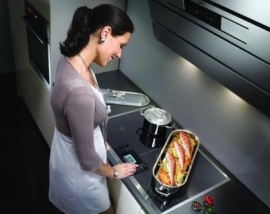 To get rid of stubborn stains after meals, you can use products specifically designed for this operation so as not to damage the surface. Search in the store sprays and gels for removing grease for ovens and ovens, the
To get rid of stubborn stains after meals, you can use products specifically designed for this operation so as not to damage the surface. Search in the store sprays and gels for removing grease for ovens and ovens, the
result of their work is far better than home remedies. “Shumanit” will help you quickly forget about permanent and stubborn stains. Spray the dirty area profusely, wait a while and wipe the plate with a sponge or cloth. The disadvantage of such products is the unpleasant smell, so if you process both the hob and the oven at the same time, a cotton gauze bandage can be a good idea. And make sure the spray doesn’t come in contact with food and clean dishes. Wear rubber gloves!
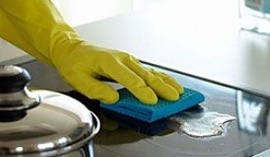 Use only delicate fabrics (preferably microfiber) to dry the stove. Glass-ceramic hobs are very easy to scratch, so you don’t even need to move the dishes on its surface. Be sure to adjust the diameter of the pots and pans to the diameter of the hob you are using. And so cooking utensils are generally suitable for induction or glass-ceramic hobs.
Use only delicate fabrics (preferably microfiber) to dry the stove. Glass-ceramic hobs are very easy to scratch, so you don’t even need to move the dishes on its surface. Be sure to adjust the diameter of the pots and pans to the diameter of the hob you are using. And so cooking utensils are generally suitable for induction or glass-ceramic hobs.
Gas stove care (stainless steel hobs)
Cleaning a gas stove can be extremely tedious. This is due to the need to clean cast iron grilles and burners. Do not give up! Here are our effective ways to get your hob in perfect condition:
1.
Turn off the hob before starting work and make sure it is cold.
3.
Immerse the racks in a bowl filled with dishwashing liquid and water for a few minutes. Then gently rub them with a sponge dipped in detergent. It is most convenient to carry out this whole procedure in the bathroom (especially if the stove grill is common to all burners). If you are experimenting, start by testing a new detergent on a small grid area.
4.
Place the burners in a bowl with vinegar or citric acid and let stand for about 30-60 minutes. Then clean and dry the burners with a cloth or sponge. You can also use aluminum foil to remove stubborn stains.
5.
Before you start cleaning the hob, remove all pieces of food from it. Apply a cleanser on it and leave it for a while to soften the stubborn food residue.
If you cook a
lot at home, actively using a gas stove, then you can spring up in a way to prevent contamination of stoves in restaurants … After removing the grills and burners, lay foil sheets on a clean hob, carefully place them and secure with grills and burners . As it gets dirty, simply remove the old foil and attach a new one to the hob, saving time and effort when cleaning the hob.
You can remove particularly stubborn dirt with a special board scraper. Be careful, however, that this method does not harm your hob by performing the test on a small, hard-to-see surface. If even that doesn’t work, apply a thick homemade paste of water and baking soda on the surface and let it stand for 20-30 minutes. Test the product in a small space to make sure it is safe for the hob. Keep in mind that it is better not to save money here, but before using the powder, test the liquid fat remover. The devastating effect of abrasive cleaners may not be noticed immediately, and then you will find microcracks only after repeated use.
Despite its many advantages over more traditional kitchen helpers, the induction hob will get dirty like other household appliances.
And while this is a good problem for a good housewife, the catch is that you need to be able to wash and clean the hob: there are certain care rules that should not be violated in any way.
Since the induction hob is a sophisticated electronic device made from materials that are easily scratched, you need to know a few things about care before you start using it.
The most important thing to remember is that the kitchen hob should not coexist with household appliances that have a metal body. This is, for example, a refrigerator, freezer, dishwasher, etc. If this cannot be avoided, you will need to apply an airtight layer to the places with the highest metal shell temperature of nearby electrical appliances.
Caring for the board is a responsible job
Now you need to ensure a good air exchange near the hob. The kitchen hob should be at least a few tens of inches away from the nearest walls and floor. The materials to it must withstand temperatures of at least 100 degrees Celsius.
How to take care not to harm
In most cases, when it comes to cleaning and washing the hob, they think of induction-type household appliances with an upper glass-ceramic hob. This material is technologically more than metal and plastic, but at the same time requires special care.
Rules to follow:
- Choose individual wipes or sponges exclusively for cleaning and washing the hob. This way you will achieve maximum cleanliness of the kitchen hob.
- Remove all dirt only with products that are suitable for the care of glass-ceramic surfaces. If you still don’t know about them, open and read the instructions or find relevant information in another convenient way.
- In the absence of special induction hob cleaners, never use abrasive mixtures, powders or dishwashing solutions. Some of them cause irreparable damage to glass-ceramics, and then there is no way to fix it. So find a non-abrasive cream, gel or something similar.
- Always wipe the hob after cleaning and washing with a dry soft cloth or cloth – this will eliminate the appearance of ugly streaks and the formation of rust on the metal parts of the appliance.
- Caring for a glass-ceramic kitchen surface will be most effective if you immediately wipe off any stains that appear after cooking food.
- Be very careful about cleaning and washing when dealing with sugar. It is better to wipe it immediately with a towel, making a minimum of effort to move your hand. Then use existing hob care products. If there are stains from other products, you can first rinse everything with clean warm water using a soft scraper. Then follow the usual cleaning order.
- Note that washing the induction hob will work better if you pour the chemical on the sponge rather than on the hob itself.
- Many window cleaning solutions work well for cleaning hobs. But do not use oven sprays – their composition is not suitable for such purposes.
Remember the worst enemies of hobs: sugar and similar foods, steel wool pads and scrapers, and abrasive detergents.
The induction hob can break or react by crushing when exposed to mechanical precision impact. For example, the sudden fall of a heavy knife, chopping ax, or chopping hammer can sometimes lead to problems.
Note that the hob will heat up slightly during operation, and constant splashing of the refrigerator can damage the hob.
Baking soda replaces some special induction cleaning and washing products, but use it very carefully. First put a little on a damp warm cloth, wipe the stained area, rinse with water, then wipe with a damp and then a dry towel.
Keep in mind that ordinary sunflower oil has properties similar to similar detergents. But it is better to check this fact when there are no special tools at hand.
How to care for a glass-ceramic hob (video)
As you can see, there is nothing difficult in maintaining induction hobs. The main thing is to be careful and take care immediately after cooking.
Axioms of glass ceramics:
Glass ceramics do not like aluminum, sugar and plastic.
Do not clean glassware with a knife, brush, steel wool or abrasive cleaners.
Recommended medications
When buying a hob or stove with a glass-ceramic surface, you must buy a special detergent and scraper. These related products are sold in hardware stores and home appliance stores. Sometimes they are included in the tile (the price is included in the price of the tile or slab). If the scraper is made of plastic, then it will not last long. A steel scraper with removable metal blades is much more reliable. The design of the accessory is somewhat similar to a razor. Compared to loofahs, sponges and detergents, it is expensive. For example, a set of Electrolux can cost up to 330 rubles (scraper and a set of ten replacement blades). Buying a special detergent for washing glass ceramics (500 ml bottle) can cost from 130 to 300 rubles. In fairness, you can see that the bottle is enough for a very long time, because the costs are small. But the effect of its use is very noticeable. The glass-ceramic surface will be much easier to maintain in a perfectly clean condition, because the product not only removes scale, food residues and greasy stains, but also creates a thin protective silicone film. The film prevents the accumulation of food residues and grease, facilitates cleaning and protects the surface from liquids with a high sugar content.
Cleaning technology:
AEG expert advice recommends: “First remove food residue with a scraper. Aluminum foil, molten plastic and burnt sugar are best removed while the surface is still warm. If this happens, the stove should be reheated to melt the dirt. Then it is easier to scrape them with a scraper. The surface must then be allowed to cool and a special glass-ceramic cleaning detergent is applied to it, rubbing it gently with a soft cloth or paper towel. After that, the surface is carefully cleaned with a wet towel and wiped dry. “
At first glance, everything is very simple and understandable. But there are some nuances that should be considered in a number of cases.
Do not wipe the surface with a dishwashing sponge. traces of detergent or grease may remain on it; when the stove is turned on, they burn out, leading to a change in surface color. The glass ceramic around the burner can be cleaned with soap and a piece of soft, clean cloth.
Grease sprays, scale, water traces and discoloration on the surface can be removed with a steel cleaner or special glass-ceramic care compounds. Detergents may only be applied to a completely cooled plate. At the end of cleaning, they must be completely removed from the surface to be cleaned, as they can have a corrosive effect on the glass-ceramic coating.
Calculus can be removed with a mild vinegar solution. If dishwashing detergents are used to maintain the glass-ceramic surface, bluish stains may remain on the surface. They do not affect the operation of the device, but are not always removed even by special joints.
Do not use stain removers or oven sprays to clean glass ceramics.
Ardo believes that glass ceramics can be cleaned with a glass cleaner.
Make sure that no solid particles such as grains of sand get on the hob. They can damage the glass-ceramic surface.
Hobs must always be dry, wet pots or splashes of salt water will adversely affect the glass ceramic.
Consumer opinion
Russians have always been characterized by great ingenuity and a creative approach to solving everyday problems. What home remedies do housewives recommend for the care of glass-ceramic coatings?
Baking soda is considered a good means of cleaning the hob. Wet powder is applied to the surface with a damp cloth and perfectly removes dirt.
To create a protective film, you can wipe the plate with a soft cloth dampened with a small amount of vegetable oil after washing the glass ceramic.
A conventional razor will successfully replace special scrapers.
Some kitchen detergents are also suitable for cleaning glass-ceramic surfaces, but they should be chosen with great care.
To follow these tips or not is a private matter for the housewife. However, do not forget that hobs and hobs with glass-ceramic coating are not very cheap, so it is better to handle them carefully, following the manufacturer’s instructions.
Traces of lime and water, grease splashes and stains with a metallic sheen (by the way, a very common problem), removing paint on the surface are removed with a stainless steel product cleaner (before cleaning, check again for abrasives). We advise you to use a special stainless steel cleaning foam from well-known manufacturers. Detergents must not come into contact with the hot glass-ceramic hob! After cleaning, the detergents are completely rinsed with clean water. If you don’t want blue stains on the stove, don’t use dishwashing detergent. These stains hopelessly spoil the appearance of the furnace and it is almost impossible to remove them even with special means. The only consolation is that they do not affect the performance of the panel.
What can damage glass ceramics?
Glass-ceramic coverings are characterized by high mechanical strength and can withstand very significant loads during the operation of the kitchen. But they are afraid of precise strikes. For example, dropping the knife down can lead to a network of cracks. In practice, such interference is rare, but in theory anything is possible.
Do not place wet and cold dishes on a hot burner, it is recommended to avoid spraying cold water on a hot surface. Nothing terrible may happen the first time, but if this ban is systematically violated, glass ceramics may not last.
The glass-ceramic plate of a tidy housewife will last much longer than that forgetful lady, whose liquid is constantly “escaping,” falling on the adjacent burners that have not yet cooled. The destruction of the coating structure occurs gradually, it becomes noticeable not immediately. But sooner or later, the cracks will become visible, the plate will become unusable.
Dry, dirty cloths are completely unsuitable for cleaning glass ceramics. They can do more harm than good by transferring old contaminants to the hob.
Two problems The
perfectly flat surface of the glass-ceramic coating works against the housewife in the event that a large amount of liquid is spilled on the stove. All this flows completely unhindered from the walls of the slab to the floor. If this is water, then everything is not so scary, but the drops of rich soup will have to be thoroughly and long and thoroughly washed from the body of the stove, furniture and floor.
Another problem is that the stove is very rarely equipped with a small diameter burner, suitable for a coffee pot or geyser. You have to choose between refusing to prepare your favorite tonic and the risk of destroying the device due to improper use.
Why we choose glass ceramics
After reading the first part of the article, many will ask a completely reasonable question: is glass ceramics worth all the hassles described above? Of course it’s worth it. After all, it is not only beautiful, but also very affordable and profitable.
Believe me, the description of the performance characteristics of conventional enameled electric ovens with heating elements-pancakes would not take up any less space. In addition, we have considered all possible situations, some of which will never happen with a single stove. In fact, a hob or hob with a glass-ceramic hob can serve for a long time and without problems.
Such attention is paid to glass ceramics precisely because it has recently appeared on the market, and it seems to be an unexplored novelty for many housewives. However, every woman is able to appreciate the unique thermal conductivity of glass-ceramics, which allows cooking dishes much faster than using a standard enameled electric oven.
High vertical thermal conductivity and low horizontal conductivity allow you to significantly increase the efficiency of the appliance, directing all the thermal energy directly to the cooking rather than to heating the entire hob.
Total energy consumption is reduced.
The glass-ceramic cools quickly, allowing a dynamic response when the switch is turned. Previously, this was only available for gas stoves.
Heating zone change. It is possible to adjust the heated area, which allows the use of dishes with different bottom diameters.
Possibility to change the shape of the heated area (you can use ducklings and gosyatnits, dishes of different configurations).
Today it has become fashionable to have glass ceramics in the kitchen. Matte black, perfectly white, with artistic patterns and varied graphics – this stove will be a perfect addition to any kitchen interior … Hobs, or heating zones of glass-ceramic hobs, are marked with a contour, thanks to which a mirror effect is achieved, which makes the design of the kitchen space modern. In addition, unlike electric furnaces, glass-ceramics heat up in seconds thanks to a new generation of High Light heating elements.
The glass-ceramic surface should be cleaned regularly, preferably after each cooking. However, do not use scratch pads or abrasive cleaners. Also, strong detergents such as oven spray, stain removers, bath cleaners or general purpose cleaners are not suitable for cleaning glass-ceramic surfaces.
To thoroughly clean the surface, first remove stubborn dirt and food debris with a scraper or cleaning sponge. Then apply a few drops of a special glass-ceramic cleaning liquid to the cooled plate and wipe with a paper towel or a clean cloth. Finally, wipe the plate with a damp cloth and wipe it with the dry or soft side of a special cleaning sponge.
According to Hansa expert, the hob will retain its beauty and shine for a long time if you carefully consider the choice of dishes. Pots and pans should be sized to fit the size of the hob. To avoid damaging the glass-ceramic surface, it is better to choose dishes with a smooth bottom. When hot, make sure the dishes are flat and flat on the hob. Thus heat energy is transferred in the best possible way. The optimal bottom thickness is 2-3 mm for steel enamel and 4-6 mm for stainless steel with a sandwich bottom – three-layer or five-layer bottom made of different alloys and metals. The three-layer bottom is made of two layers of stainless steel and between them one layer of copper or aluminum. This design is called heat distribution: the dishes retain heat for a long time and the food does not burn. The walls of the dishes are often made in several layers – this technology is called Tri-ply. Stainless steel makes the dishes durable, and aluminum helps to quickly distribute heat over the entire surface of the bottom. The five-layer “sandwich” consists of two layers of stainless steel, one layer of pure aluminum and two layers of aluminum alloy – this is the best option for dishes for glass-ceramic hobs. In any case, the food will only come into contact with safe stainless steel. Also, don’t forget to put the pan first and then turn on the burner. one layer of pure aluminum and two layers of aluminum alloy – this is the best option for glass-ceramic cookware. In any case, the food will only come into contact with safe stainless steel. Also, don’t forget to put the pan first and then turn on the burner. one layer of pure aluminum and two layers of aluminum alloy – this is the best option for glass-ceramic cookware. In any case, the food will only come into contact with safe stainless steel. Also, don’t forget to put the pan first and then turn on the burner.
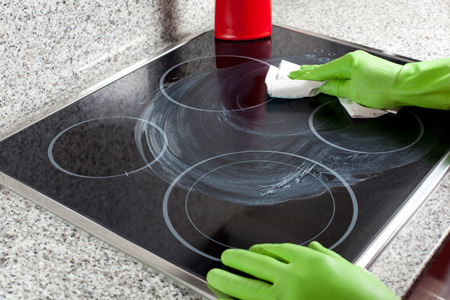
If you use a cold glass-ceramic surface as a work surface after cooking, be sure to wipe it to avoid scratches due to remaining grains of sand from the food. And, most importantly, when moving utensils, always lift it to avoid scratches and scratches on the hob.
However, even if you know all the warnings for glass-ceramic stoves and it is safe to play, it is difficult to keep track of everything in the kitchen, anticipate and anticipate everything when the work process is in full swing. If plastic, aluminum foil, sugar, or sugar-containing foods suddenly come in contact with the hot hob, remove the dirt from the hob as soon as possible with a scraper. If these objects start to melt, they can damage the glass-ceramic surface. Therefore, apply a special glass-ceramic cleaner to it before cooking food with a large amount of sugar.
The glass-ceramic from which the hob is made is a durable, reliable and durable material that, with proper care and handling, meets all the requirements and standards for household hobs. Thus, by following simple and easy tips, you will keep your faithful helper in excellent condition for a long time and without unnecessary effort.
Discussion
Good rules. From myself I can say that it has never been a big problem for me to take care of my hot spot, it’s nice to take care of nice equipment so it looks like new. And so with everything in the house;)
Thanks for the good advice, even though I have a glass-ceramic stove, I didn’t know much, especially in nursing. Well, the dishes should be suitable for such a stove, I use cast aluminum dishes called Litta brand VARI. It is a pleasure to cook on such a stove with such dishes. Nothing burns, cooks without unnecessary hassle and is easy to take care of.
Comment on the article “Rules for the care of glass-ceramic furnaces”
The topic was created to discuss the article Rules for the care of glass-ceramic furnaces. How to prolong shine and preserve beauty Thank you for the good advice, even though I have a glass-ceramic hob, I didn’t know much, especially in nursing. Well, the dishes should …
Glass-ceramic hob, care. Tell me how to get rid of “rainbow paint” stains on the glass-ceramic surface of the furnace. Rules for the care of glass-ceramic furnaces. If these objects start to melt, they can damage the glass-ceramic surface.
Rules for the care of glass-ceramic furnaces. Finally, wipe the plate with a damp cloth and wipe it with the dry or soft side of a special cleaning sponge. Enameled steel, glass ceramics? Are you happy, aren’t you? Glass-ceramic hob, care.
I use Top House for glass ceramics and scrapers. Glass for glass ceramics? Tell me, if you have a glass-ceramic hob Is it possible to use a pan made of so-called white cast iron on a glass-ceramic hob?
Rules for the care of glass-ceramic furnaces. Hobs or heating zones Glass-ceramic hobs are marked with a contour and therefore a mirror effect is achieved which must be cleaned regularly.
Stove – glass ceramics, pancakes, induction? Stoves and stoves. Household equipment and computers. Selection and purchase of computers, household appliances, discussion of models, features: laptop, smartphone, vacuum cleaner, refrigerator, dishwasher, microwave …
Rules for the care of glass-ceramic furnaces. How to clean glass ceramics? Tell me, who cleans owl furnaces with what? In terms of glass-ceramics? Clean the ceramic hob. How to clean the surface of a ceramic hob. The milk escaped, and the ugly remained …
What cleaners should I use for the stove if it is made of glass ceramic? And if it is gas or electricity with enamelled glass-ceramic – how to wash. Can you share what you wash the plates? Not so long ago we bought a new one, but there are already places that take up nothing.
Ceramic hob, care .. Household appliances. Household. Household maintenance: tips on housekeeping, cleaning, buying and glass-ceramic hob, care. Tell me how to get rid of “rainbow paint” stains on the glass-ceramic surface of the furnace.
How to take care of glass ceramics? Devices. Household. Household maintenance: tips on housekeeping, cleaning, buying and using household appliances, repairs Section: Household appliances (Who has been using a glass-ceramic hob for a long time).
Can a Turk get glass ceramics? Devices. Household. Household maintenance: tips on housekeeping, cleaning, buying and using household appliances And it’s small, it worked fine on the previous ordinary electric stove, but how about glass ceramics?
Rules for the care of glass-ceramic furnaces. Induction hobs can have a glass-ceramic surface. Glass-ceramic hob, care. Tell me how to get rid of “rainbow paint” stains on the glass-ceramic surface of the furnace.
Care of glass ceramics. Devices. Household. Household maintenance: tips on maintaining, cleaning, purchasing and using the acquired electric glass-ceramic hob Kaiser C 502.60 TeKdCs. Which surface care products do you recommend?
Can I use a so-called white cast iron pan on a glass-ceramic hob? I use Top House for glass ceramics and scrapers. Rules for the care of glass-ceramic furnaces. Today it has become fashionable to have glass ceramics in the kitchen.
Rules for the care of glass-ceramic furnaces. The burners, ie the heating zones of the glass-ceramic hob, are marked in the shape of a contour, which is why the effect of a mirror surface is achieved, which makes I Use Top House for glass-ceramics and …
Learn to use email stove !!!. Help. About her, about the girl. Discussion of issues about a woman’s life in the family, at work, relationships with men. I lived in Moscow for a year and a half with such a stove, but I never learned how to use it – then, however, not really ..
Rules for the care of glass-ceramic furnaces. The burners, ie the heating zones of the glass-ceramic hob, are marked with a contour, and thanks to that a mirror effect is achieved, which makes the design of the kitchen space modern.
Glass-ceramic plate. Who’s talking about what, and I’m still talking about the same thing :-)) Another question arose – I used the stove once and found that the whole plate heats up during cooking, not just the space above the burner – for some reason it seems wrong to me .
Glass ceramics: should dishes be changed? People, I want to buy a glass-ceramic hob (hi-light, not induction). The question is: how many dishes need to be replaced? Can ordinary pans (cast iron, Soviet) be used? Big pots?
I have had a glass-ceramic hob for 5 years. But the green amphibian strangled me to buy an expensive pressure cooker. And I used my old Soviet. On the burner on which I put the pressure cooker, the stain was wiped off (i.e. the surface of the oven at this point became dull).





